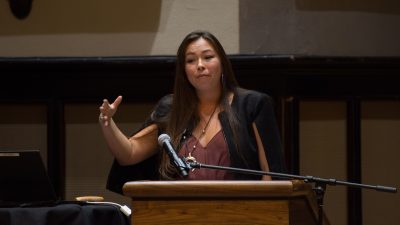Members of campus and the community gathered in the University of Idaho Administration Building Auditorium to listen to a nationally renowned photographer present her work Oct. 11.
At 6 p.m., Matika Wilbur, a member of the Swinomish and Tulalip tribes of the State of Washington, showed her work on “Project 562,” the “solution to historical inaccuracies, stereotypical representations and silenced Native American voices in massive-media,” according to Wilbur’s artist statement. According to project562.com, Project 562 is Wilbur’s attempt to photograph Native Americans from more than 562 Tribal Nations in the United States.

Connor McCaughan | Argonaut
Photographer Matika Wilbur talks to students and community members about Native American stereotypes Wednesday in the Administration building auditorium.
During her presentation, hosted by the UI history department, Wilbur showed numerous pictures from her project and retold the stories of the people she has met along the way in an effort to minimize the common historical “feathered and leathered” image of Native American people. With her photographs of members from more than 400 tribes in the United States, Wilbur said she is working to change the way people see Native America.
“We want to drive conversations about how U.S. citizens can evolve beyond the misappropriation and neglect of indigenous peoples,” she said.
While conducting her project, Wilbur said she found it interesting how people chose to present themselves with what they wore and how they posed when she took their photographs. She said that the “leathered and feathered” historical image is what people want to see when they look up “Native Americans,” but it does not represent the modern American Indian.
“The preponderance of historical images is plaguing our minds,” she said.
Wilbur said individuals can take responsibility and change the reality of the society that perpetuates historical amnesia. She said she wants people to remember that American Indians are real and the land we walk upon is indigenous land.
“We have to begin using an outward love language,” she said.
Wilbur’s presentation drew a sizable crowd to the auditorium, diverse with a mix of students and non-students. Steve Morrison, a resident of Albion, Washington, said he attended the event because he has been interested in Native American studies for 40 plus years. Morrison said he enjoyed that Wilbur shared some of her culture with the audience.
“I loved her genuineness, laughter and humanness,” he said.
Aleta Rutherford, a UI secondary education major, said she thought Wilbur’s presentation was interesting because it brought a new, unusual perspective to UI.
UI assistant professor of history, Matthew Fox-Amato, said the university organized the event around two main ideas. He said the goal was to provide a voice that explains how we can move beyond deep-rooted stereotypes and also to show a project that intersects with the courses offered in the UI history and American Indian studies programs.
Fox-Amato said while this event is clearly connected with Indigenous Peoples Day, the timing simply worked out that Wilbur’s presentation fell during the same week as the holiday.
“I hope that students and those affiliated with campus will consider the rich diversity in the images that Wilbur presented,” he said.
Jordan Willson can be reached at [email protected]
